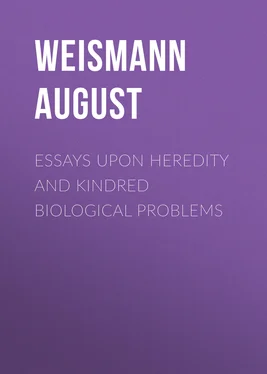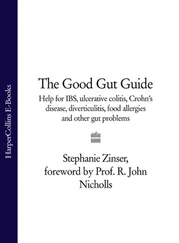August Weismann - Essays Upon Heredity and Kindred Biological Problems
Здесь есть возможность читать онлайн «August Weismann - Essays Upon Heredity and Kindred Biological Problems» — ознакомительный отрывок электронной книги совершенно бесплатно, а после прочтения отрывка купить полную версию. В некоторых случаях можно слушать аудио, скачать через торрент в формате fb2 и присутствует краткое содержание. Жанр: foreign_antique, Биология, на английском языке. Описание произведения, (предисловие) а так же отзывы посетителей доступны на портале библиотеки ЛибКат.
- Название:Essays Upon Heredity and Kindred Biological Problems
- Автор:
- Жанр:
- Год:неизвестен
- ISBN:нет данных
- Рейтинг книги:5 / 5. Голосов: 1
-
Избранное:Добавить в избранное
- Отзывы:
-
Ваша оценка:
- 100
- 1
- 2
- 3
- 4
- 5
Essays Upon Heredity and Kindred Biological Problems: краткое содержание, описание и аннотация
Предлагаем к чтению аннотацию, описание, краткое содержание или предисловие (зависит от того, что написал сам автор книги «Essays Upon Heredity and Kindred Biological Problems»). Если вы не нашли необходимую информацию о книге — напишите в комментариях, мы постараемся отыскать её.
Essays Upon Heredity and Kindred Biological Problems — читать онлайн ознакомительный отрывок
Ниже представлен текст книги, разбитый по страницам. Система сохранения места последней прочитанной страницы, позволяет с удобством читать онлайн бесплатно книгу «Essays Upon Heredity and Kindred Biological Problems», без необходимости каждый раз заново искать на чём Вы остановились. Поставьте закладку, и сможете в любой момент перейти на страницу, на которой закончили чтение.
Интервал:
Закладка:
In answer to my question as to whether the males of any species of butterfly or moth are known to pass a life of different length from that of the female, Dr. Speyer stated that he knew of no observations on this point.
The following are the only instances of well-established direct observations upon single individuals, in my possession 12:—
Pieris napi , var. bryoniae [male] and [female], captured on the wing: lived in confinement ten days, and were then killed.
Vanessa prorsa lived at most ten days in confinement.
Vanessa urticae lived ten to thirteen days in confinement.
Papilio ajax. According to a letter from Mr. W. H. Edwards, the female, when she leaves the pupa, contains unripe eggs in her body, and lives for about six weeks—calculating from the first appearance of this butterfly to the disappearance of the same generation 13. The males live longer, and continue to fly when very worn and exhausted. A worn female is very seldom seen;—‘I believe the female does not live long after laying her eggs, but this takes some days, and probably two weeks.’
Lycaena violacea. According to Mr. Edwards, the first brood of this species lives three to four weeks at the most.
Smerinthus tiliae. A female, which had just emerged from the pupa, was caught on June 24th; on the 29th pairing took place; on the 1st of July she laid about eighty eggs, and died the following day. She lived nine days, taking no food during this period, and she only survived the deposition of eggs by a single day.
Macroglossa stellatarum. A female, captured on the wing and already fertilized, lived in confinement from June 28th to July 4th. During this time she laid about eighty eggs, at intervals and singly; she then disappeared, and must have died, although the body could not be found among the grass at the bottom of the cage in which she was confined.
Saturnia pyri. A pair which quitted the cocoons on the 24th or 25th of April, remained in coitu from the 26th until May 2nd—six or seven days; the female then laid a number of eggs, and died.
Psyche graminella. The fertilized female lives some days, and the unfertilized female over a week (Speyer).
Solenobia triquetrella. ‘The parthenogenetic form (I refer to the one which I have shown to be parthenogenetic in Oken’s ‘Isis,’ 1846, p. 30) lays a mass of eggs in the abandoned case, soon after emergence. The oviposition causes her body to shrivel up, and some hours afterwards she dies. The non-parthenogenetic female of the same species remains for many days, waiting to be fertilized; if this does not occur, she lives over a week.’ ‘The parthenogenetic female lives for hardly a day, and the same is true of the parthenogenetic females of another species of Solenobia ’ ( S. inconspicuella ?). Letter from Dr. Speyer.
Psyche calcella, O. The males live a very short time; ‘those which leave the cocoon in the evening are found dead on the following morning, with their wings fallen off, at the bottom of their cage.’ Dr. Speyer.
Eupithecia , sp. ( Geometridae ), ‘when well-fed, live for three to four weeks in confinement; the males fertilize the females frequently, and the latter continue to lay eggs when they are very feeble, and are incapable of creeping or flying.’ Dr. Speyer.
The conclusions and speculations in the text seem to be sufficiently supported from this short series of observations. There remains, as we see, much to be done in this field, and it would well repay a lepidopterist to undertake some exact observations upon the length of life in different butterflies and moths, with reference to the conditions of life—the mode of egg-laying, the degeneracy of the wings, and of the external mouth-parts or the closure of the mouth itself. It would be well to ascertain whether such closure does really take place, as it undoubtedly does in certain plant-lice.
VII. Coleoptera
Melolontha vulgaris. Cockchafers, which I kept in an airy cage with fresh food and abundant moisture, did not in any case live longer than thirty-nine days. One female only, out of a total number of forty-nine, lived for this period; a second lived thirty-six days, a third thirty-five, and a fourth and fifth twenty-four days; all the rest died earlier. Of the males, only one lived as long as twenty-nine days. These periods are less by some days than the true maximum duration of life, for the beetles were captured in the field, and had lived for at least a day; but the difference cannot be great, when we remember that out of forty-nine beetles, only three females lived thirty-five to thirty-nine days, and only one male twenty-nine days. Those that died earlier had probably lived for some considerable time before being caught.
Exact experiments with pupae which have survived the winter would show whether the female really lives for ten days more than the male, or whether the results of my experiment were merely accidental. I may add that coitus frequently took place during the period of captivity. One pair, observed in this condition on the 17th, separated in the evening; they paired again on the morning of the 18th, and separated in the middle of the day. Coitus took place between another pair on the 22nd, and again on the 26th.
I watched the gradual approach of death in many individuals: some days before it ensued, the insects became sluggish, ceased to fly and to eat, and only crept a little way off when disturbed: they then fell to the ground and remained motionless, apparently dead, but moved their legs when irritated, and sometimes automatically. Death came on gradually and imperceptibly; from time to time there was a slow movement of the legs, and at last, after some hours, all signs of life ceased.
In one case only I found bacteria present in great numbers in the blood and tissues; in the other individuals which had recently died, the only noticeable change was the unusual dryness of the tissues.
Carabus auratus. An experiment with an individual, caught on May 27th, gave the length of life at fourteen days; this is probably below the average, since the beetles are found, in the wild state, from the end of May until the beginning of July.
Lucanus cervus. Captured individuals, kept in confinement, and fed on a solution of sugar, never lived longer than fourteen days, and as a rule not so long. The beetles appear in June and July, and certainly cannot live much over a month. As is the case with many beetles appearing during certain months, the length of the individual life is shorter than the period over which they are found. Accurate information, especially as to any difference between the lengths of life in the sexes, is not obtainable.
Isolated accounts of remarkably long lives among beetles are to be found scattered throughout the literature of the subject. Dr. Hagen, of Cambridge, Mass., has been kind enough to draw my attention to these, and to send me some observations of his own.
Cerambyx heros. One individual lived in confinement from August until the following year 14.
Saperda carcharias. An individual lived from the 5th of July until the 24th of July of the next year 15.
Buprestis splendens. A living individual was removed from a desk which had stood in a London counting-house for thirty years; from the condition of the wood it was evident that the larva had been in it before the desk was made 16.
Blaps mortisaga. One individual lived three months, and two others three years.
Blaps fatidica. One individual which was left in a box and forgotten, was found alive when the box was opened six years afterwards.
Blaps obtusa. One lived a year and a half in confinement.
Читать дальшеИнтервал:
Закладка:
Похожие книги на «Essays Upon Heredity and Kindred Biological Problems»
Представляем Вашему вниманию похожие книги на «Essays Upon Heredity and Kindred Biological Problems» списком для выбора. Мы отобрали схожую по названию и смыслу литературу в надежде предоставить читателям больше вариантов отыскать новые, интересные, ещё непрочитанные произведения.
Обсуждение, отзывы о книге «Essays Upon Heredity and Kindred Biological Problems» и просто собственные мнения читателей. Оставьте ваши комментарии, напишите, что Вы думаете о произведении, его смысле или главных героях. Укажите что конкретно понравилось, а что нет, и почему Вы так считаете.












